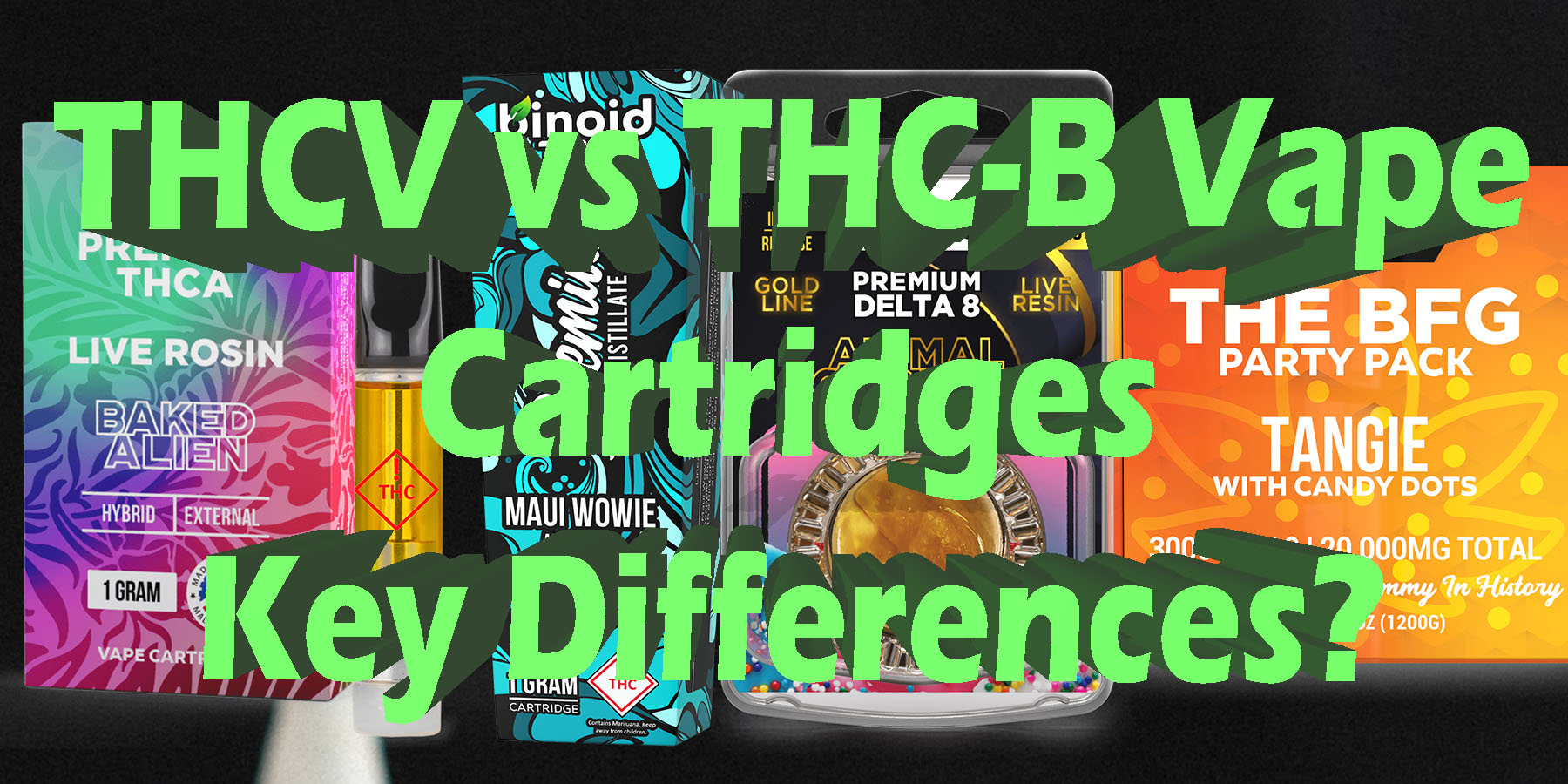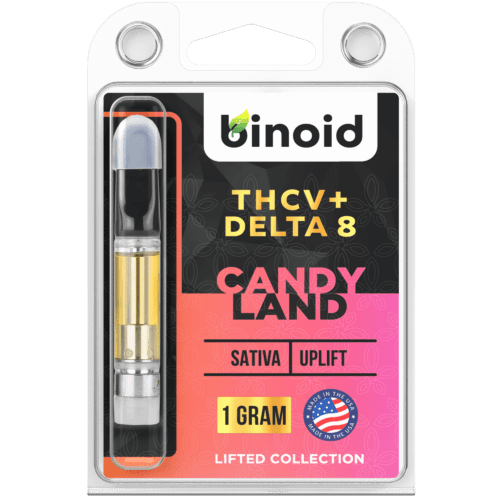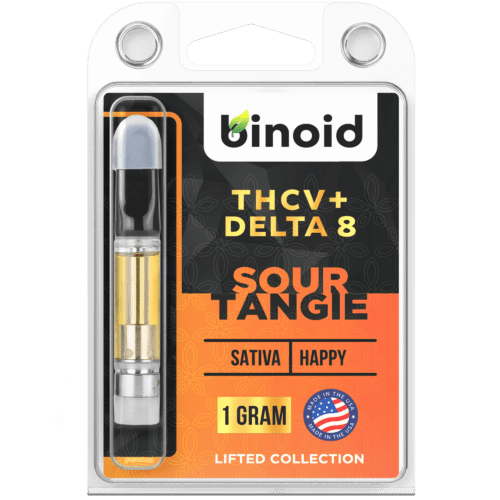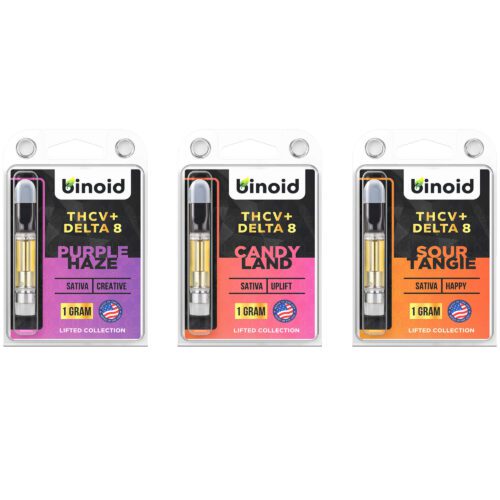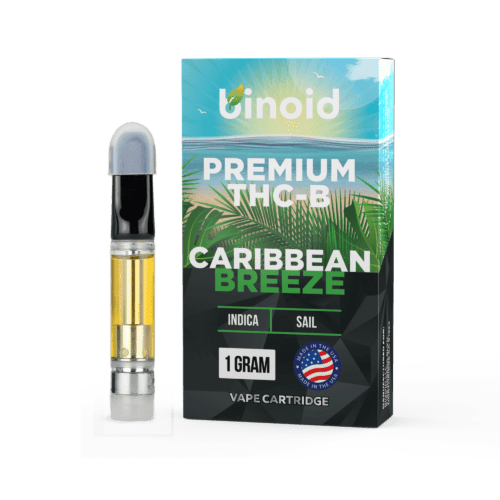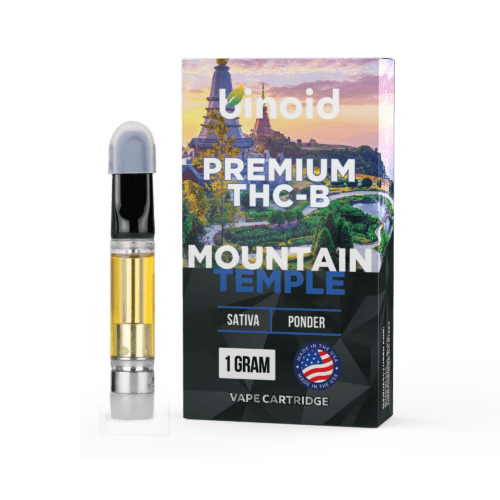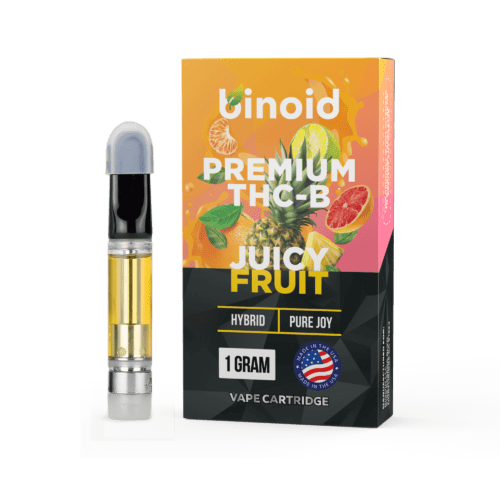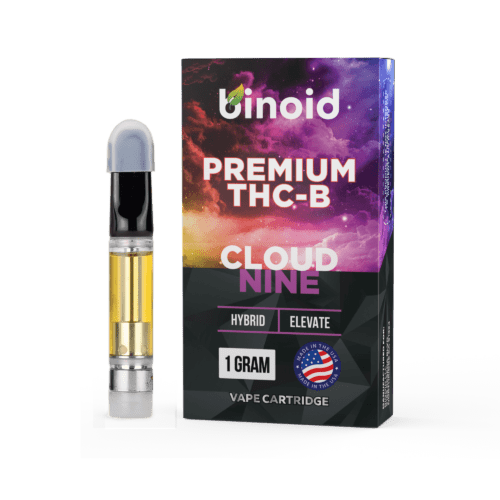In the sophisticated world of modern cannabinoids, the most compelling conversations often revolve around two key qualities: the nuanced character of the experience and the fundamental chemical structure of the molecule itself. One defines the subjective journey—its specific shade of euphoria, its intensity, and its feel in both mind and body. The other dictates its performance—its potency, its duration, and its unique interaction with our internal systems.
Rarely do two advanced compounds embody this fascinating dichotomy as perfectly as the subjects of our current exploration, especially when delivered through the precision of a vape cartridge. This brings us to the heart of the matter for the experienced user: the insightful comparison of THCV vape cartridges vs. THC-B vape cartridges.
The decision between them is not simply about potency, but about what a user prioritizes in their session. Is the goal a moment of profound, immersive bliss, or is it a sustained, well-rounded euphoria from a remarkably durable compound? Exploring the science and user experiences behind each will illuminate the answer.
To Buy Cannabinoid Vape Cartridges Click Here
Recommended products
What are Cannabinoids?
To truly appreciate the profound differences in the THCV and THC-B matchup, one must first possess a firm understanding of the fundamental building blocks of their composition: cannabinoids. In the broadest scientific sense, cannabinoids represent a diverse class of chemical compounds that are defined by their ability to interact with and influence the body’s endocannabinoid system. These compounds are the primary active ingredients responsible for the effects associated with the cannabis plant, but their origins are not confined to botanical sources alone.
The scientific community generally categorizes these molecules into three distinct groups: phytocannabinoids, which are synthesized by plants (most famously, the Cannabis sativa plant); endocannabinoids, which are produced naturally within the bodies of humans and other vertebrate animals; and synthetic cannabinoids, which are created artificially in a laboratory setting. Phytocannabinoids, like the THCV and THC-B we are exploring today, have a molecular structure that allows them to interface with our bodies’ internal systems, orchestrating a complex symphony of physiological responses.
The discovery and subsequent understanding of this intricate relationship are rooted in the endocannabinoid system (ECS), a crucial and sophisticated cell-signaling network. The ECS plays a vital role in regulating a vast array of functions to maintain a state of internal physiological balance, a concept known as homeostasis.
This system is composed of three core components: endocannabinoids (such as anandamide, often called the “bliss molecule,” and 2-arachidonoylglycerol, or 2-AG), which are the body’s own naturally produced cannabinoid molecules; receptors that these compounds bind to (primarily CB1 receptors, found mostly in the brain and central nervous system, and CB2 receptors, located predominantly in the peripheral nervous system and immune cells); and enzymes that metabolize and break down the endocannabinoids once they have served their signaling purpose.
Phytocannabinoids are able to produce their effects because their molecular shapes allow them to mimic or otherwise influence our natural endocannabinoids, binding to these same receptors and thus modulating cellular activity.
Within the vast family of over one hundred identified phytocannabinoids, there is a clear and important distinction between major and minor compounds, as well as a distinction between their active and acidic forms. Major cannabinoids, such as cannabidiol (CBD) and the well-known Delta 9 THC, are the most abundant active compounds and have been the subject of extensive scientific research and public discussion for many decades. In contrast, minor cannabinoids exist in much smaller, often trace, amounts. THCV and THC-B both fall squarely into this category.
Furthermore, most cannabinoids exist in the raw cannabis plant in an acidic form, such as THCA and CBDA. These are known as cannabinoid acids and are the biosynthetic precursors to the active compounds we are more familiar with. THCA, for example, is a major cannabinoid in its raw form, often the most abundant compound in uncured hemp flower.
This fundamental distinction between different types of cannabinoids is absolutely essential to understanding the landscape of the modern hemp industry. The 2018 Farm Bill, a landmark piece of federal legislation, federally legalized hemp and all hemp-derived products, provided they contain no more than 0.3% Delta 9 THC by dry weight. This legal framework, while sharply focused on restricting the specific molecule of Delta 9 THC, inadvertently created a massive opportunity for the scientific exploration and commercialization of other cannabinoids that could be legally sourced from compliant hemp.
This legal pathway, combined with significant advancements in agricultural breeding, chemical conversion, and purification techniques, has directly enabled the rise of products centered around compounds like the powerful homologs THCV and THC-B, empowering consumers with a sophisticated palette of experiences.
Recommended products
What are Cannabinoid-Infused Vape Cartridges and How are They Typically Created?
Cannabinoid-infused vape cartridges, often simply called “vape carts,” are small, pre-filled containers that hold a liquid formulation of purified cannabinoid distillate and, typically, aromatic terpenes. These self-contained units are meticulously engineered to attach to a compatible battery, commonly known as a vape pen or 510-thread battery, which provides the necessary electrical power to heat the liquid and instantaneously transform it into an inhalable vapor. The primary function of a vape cartridge is to offer a convenient, discreet, and highly efficient method for consuming cannabinoids.
Unlike other consumption methods that require more preparation or have a significantly delayed onset, such as edibles, vaping allows for the rapid delivery of the active compounds directly into the bloodstream through the vast surface area of the lungs. This results in effects that can be felt almost immediately, often within a matter of minutes, providing users with unparalleled control over their experience as they can take small draws and precisely gauge the effects before deciding to continue.
The marketplace for cannabinoid vape cartridges is incredibly diverse, with products available in a multitude of shapes, sizes, and materials designed to suit various consumer preferences and accommodate ongoing technological advancements. The most ubiquitous size is the 1-gram (or 1mL) cartridge, which offers a substantial amount of oil that serves as a happy medium for both regular and occasional users. However, smaller half-gram options remain popular for those wishing to sample a new strain, while larger 2-gram, 3-gram, and even 5-gram disposable vape pens have emerged for users seeking maximum convenience and longevity.
In terms of shape, the classic cylindrical design with a 510-thread connection remains the undisputed industry standard due to its near-universal compatibility with the vast majority of batteries. Yet, some brands have pioneered proprietary pod-style systems that often feature a sleeker, more modern aesthetic and a magnetic connection, although they require a specific, brand-locked device to function. The materials used in cartridge construction are also a key differentiator, profoundly impacting performance, safety, and the purity of the user experience, with a clear hierarchy from basic plastics to premium glass and ceramic constructions.
While external designs may vary, the core components of a standard vape cartridge are universal and work in precise concert to deliver a smooth, flavorful, and consistent experience. Each part plays a critical, non-negotiable role in the device’s function, from the point of contact with the user to the electrical connection with the power source. A detailed breakdown reveals the intricate design that ensures safety and proper function:
Mouthpiece: This is the uppermost part of the cartridge through which the user inhales the vapor. Mouthpieces are crafted from a variety of materials, including common options like plastic, more premium choices like heat-resistant ceramic, and stylish alternatives like metal or wood. The shape can also differ—flat, rounded, or ergonomically contoured (“duckbill”)—to enhance comfort. The material choice is not merely aesthetic; ceramic mouthpieces, for instance, are excellent at dissipating heat, ensuring a cooler and more comfortable draw.
Tank/Reservoir (Chamber): The tank is the main body of the cartridge that holds the precious cannabinoid-infused oil. It must be transparent to allow the user to monitor the remaining liquid. While some budget cartridges may use polycarbonate plastic, high-quality tanks are almost exclusively made from borosilicate glass. This type of glass is highly durable and, most importantly, non-reactive, ensuring that there is no chemical leaching into the oil, which could alter the flavor and compromise the purity of the terpenes and cannabinoids.
Atomizer/Heating Element: The atomizer is the functional heart of the cartridge, responsible for heating the oil to its precise vaporization point (typically between 300-400°F). It consists of a heating coil wrapped around or embedded within a wicking material that draws in the oil. In modern, high-end cartridges, the atomizer core is made of a porous ceramic. This technology, often referred to by brand names like CCELL, provides exceptionally even heat distribution and a larger surface area, which prevents direct contact between the hot coil and the oil. This indirect heating is crucial for preventing burning, which would create a harsh taste and potentially harmful byproducts, and for preserving the delicate and complex flavor profile of the terpenes.
Base/Connector: The base is the bottom part of the cartridge that houses the atomizer and features the threading used to connect the device to a battery. The most common type is the 510-thread (referring to the 10 threads at 0.5 mm per thread), which has become the universal standard, ensuring interoperability between most cartridges and batteries on the market. The base also contains the airflow intakes—small holes that allow air to enter and mix with the vapor—and the electrical connection point that draws power from the battery to activate the heating element when the user inhales or presses a button.
The production of a cannabinoid-infused vape cartridge is a meticulous, multi-stage process that merges precision manufacturing with sophisticated chemical science to ensure a safe, effective, and enjoyable final product. This complex journey can be broken down into three distinct parts: the fabrication of the physical hardware, the formulation of the specialized oil, and the final assembly and rigorous quality control.
Part 1: How the Cartridge Itself is Made and Constructed
The manufacturing of the empty cartridge begins with the high-precision fabrication of its individual components in specialized facilities. The borosilicate glass for the tank is molded and cut to exact specifications. The ceramic for the atomizer core is created from refined mineral powders, which are then fired at extremely high temperatures and shaped, after which the metallic heating coil is carefully integrated. The mouthpiece and base are also manufactured, often through injection molding for plastics or CNC (Computer Numerical Control) machining for metals.
These separate parts are then assembled in a sterile, dust-free clean-room environment (often adhering to ISO standards) to prevent any contamination. Throughout this process, stringent quality control is paramount, with manufacturers conducting tests for air-tightness to prevent leaks, ensuring proper airflow resistance for a good draw, and verifying that the electrical connections are sound and the 510-threading is perfectly machined.
Part 2: How the Cannabinoid-Infused Vape Oil is Made
This highly scientific stage starts with legally compliant, high-quality hemp biomass. The cannabinoids are first extracted from the plant material using various methods. For stable distillates, supercritical CO2 or ethanol extraction is common. For more volatile, full-spectrum extracts rich in acidic cannabinoids, cold extraction methods using solvents like butane or propane are often used to create “live resin.”
After extraction, the oil is refined. For minor cannabinoids, this may involve complex isomerization to convert a precursor like CBD into the target molecule. For major cannabinoids, it may involve distillation to achieve high purity. Finally, this purified oil is formulated, often by reintroducing carefully selected terpene profiles to create the desired flavor, aroma, and strain-specific effects.
Part 3: Bringing It All Together
In the final stage, the precisely formulated cannabinoid and terpene mixture is gently heated to reduce its viscosity and is then carefully injected into the empty, assembled cartridges. This is typically done using automated filling machines in a sterile environment to ensure dosage consistency and prevent contamination. Once filled, the cartridges are securely capped or sealed to create an airtight container that prevents any leakage. The last and arguably most critical step is comprehensive third-party lab testing.
A statistically significant sample from each batch is sent to an independent, ISO-accredited laboratory. There, it is tested for potency (to confirm cannabinoid percentages), purity (to ensure it is free from residual solvents, heavy metals, pesticides, and microbial contaminants), and legal compliance (to verify the Delta 9 THC level is at or below the 0.3% threshold). Only after passing these rigorous tests is the batch approved for packaging and release to the market.
Recommended products
Breaking Down Today’s Cannabinoid Vape Cartridges Matchup: THCV Vape Cartridges vs. THC-B Vape Cartridges
With a clear understanding of cannabinoid fundamentals and vape cartridge production, we can now examine the main event. This is a particularly fascinating matchup because it pits two stimulating, “Sativa-like” cannabinoids against each other, both of which have garnered immense popularity among users seeking an energetic experience. This is not a comparison of a mild versus a strong compound, but a deep dive into two different types of uplifting effects. On one side stands THCV, a popular homolog known for its classic, cerebrally euphoric high. On the other stands THC-B, a unique homolog celebrated for its clean, functional, and focused stimulation. Exploring the science and reported effects behind these two energetic compounds is key to making an informed choice that aligns with your specific preferences.
Contender #1: THCV Vape Cartridges
Entering the matchup is a truly unique and fascinating contender that has rapidly gained a dedicated following among cannabinoid connoisseurs seeking an experience that defies conventional expectations: THCV. Unlike the THC variants that primarily modulate the intensity of a familiar effect, THCV introduces a completely different set of characteristics. It is most widely celebrated for its stimulating, clear-headed, and energizing properties, often drawing comparisons to a strong cup of coffee rather than to its cannabinoid relatives.
This reputation as a “get things done” cannabinoid has made it highly sought-after for daytime use, workouts, and any situation that demands sharp focus and mental acuity. THCV cartridges appeal to users who want to harness the power of a rare cannabinoid to boost productivity and elevate their state of being without the relaxation or sedation typical of other compounds.
At its core, THCV (Tetrahydrocannabivarin) is a homolog of THC, meaning it shares a similar molecular structure but differs in the length of its carbon side chain. While THC possesses a 5-carbon (pentyl) side chain, THCV has a shorter 3-carbon (propyl) side chain. This seemingly small alteration dramatically changes how the molecule interacts with the endocannabinoid system, particularly the CB1 receptors. THCV is known for having a biphasic, or dose-dependent, effect: in low doses, it is reported to act as a CB1 antagonist, meaning it can block or mute the effects of other cannabinoids like Delta 9 THC and is generally non-psychoactive.
However, in higher doses, it becomes a CB1 agonist and produces a psychoactive effect of its own, though one that is distinctly different from THC—described as a clear, stimulating, and euphoric buzz that is significantly shorter in duration. THCV was first discovered in the 1970s and is found in higher concentrations in specific African landrace Sativa strains. Still, for commercial viability, it is often synthesized from a precursor like cannabigerovarinic acid (CBGVA) to ensure a consistent and pure supply.
Now, the market for THCV vape cartridges, while newer and more niche than that for other cannabinoids, is rapidly expanding as brands innovate to showcase this unique compound’s remarkable properties. Formulators are developing a growing range of products designed to deliver THCV’s signature stimulating effects, either in its pure form or as the star player in meticulously crafted blends. These variations allow discerning consumers to select a product that perfectly aligns with their goals, whether they are seeking pure, unadulterated focus or a more layered, synergistic experience.
Shapes & Sizes: THCV cartridges are most commonly available in the industry-standard 1-gram and half-gram 510-thread formats, ensuring wide compatibility with existing batteries. Given its use case for focus and daytime activity, it is also becoming increasingly popular in sleek, all-in-one disposable vapes that are perfect for on-the-go consumption and precise, discreet dosing.
How They’re Constructed: Given the premium and often higher cost of THCV distillate, reputable brands exclusively use high-quality hardware for these cartridges. This means you will typically find them constructed with non-reactive borosilicate glass tanks and advanced ceramic atomizers. This premium construction is vital to preserve the pure, often subtly earthy flavor of the THCV oil and to ensure efficient vaporization without any risk of burning or hardware-induced contamination.
Potential Use of Live Resin or Live Rosin: While less common than with THC-centric products due to THCV’s different sourcing, some highly specialized cartridges may blend pure THCV distillate with live resin or rosin from a cannabis strain. This is done to introduce a full spectrum of natural terpenes, which can help to round out the experience and provide a more authentic flavor profile through the entourage effect, modulating the stark clarity of the pure THCV.
Strain-Infused: To further tailor the experience, THCV distillates are almost always blended with specific terpene profiles. Overwhelmingly, these are Sativa and Sativa-dominant hybrid profiles, chosen to complement and amplify THCV’s naturally energizing and focus-enhancing effects. Terpenes like limonene, pinene, and terpinolene are often used to add uplifting citrus and pine notes to the experience.
Sometimes Combined with Other Cannabinoids: THCV‘s unique properties make it an exceptional component for creating powerful and highly targeted synergistic blends. Formulators use it as a catalyst to add energy and focus to a formula:
Non-Intoxicating: When combined with CBD or CBG, the blend can offer a powerful, non-psychoactive sense of focus and clarity. The THCV provides the stimulating spark, while the CBD or CBG provides a grounded, stable feeling, creating an ideal blend for work or study.
Mild Potency: Blending THCV with a cannabinoid like Delta 10 can create an intensely energetic and motivating Sativa experience. This combination is popular among users looking for a significant boost in drive and creativity without a heavy psychoactive feeling.
Moderate Potency: THCV is very frequently combined with Delta 8 to create a “best of both worlds” balanced effect. The Delta 8 provides a gentle, relaxing body sensation and mild euphoria, while the THCV adds a layer of sharp mental focus and energy, preventing any potential sedation.
Strong Potency: For an extremely potent and intensely euphoric yet clear-headed experience, formulators may blend THCV with powerful compounds like THC-P, THC-JD, THC-H, or THC-B. These blends are designed for experienced users seeking a powerful rush of uplifting energy.
The overall effects of a THCV vape cartridge are centered around a uniquely stimulating, clear-headed, and functional experience that is quite distinct from other psychoactive cannabinoids. Users often report a surge of clean energy, heightened focus, and a notable lack of the munchies, which makes it an ideal companion for daytime productivity. Its functional aspect is its sheer engagement and alertness; it is often described as providing a motivating “buzz” that can help power through tasks without the mental fog or physical heaviness of THC. This core experience is then sculpted by its formulation.
A Sativa-strain infusion will amplify the energetic qualities to their peak, while blending it with live resin can add a more complex, full-bodied character to the stark clarity. The addition of other cannabinoids creates a spectrum of possibilities; combining it with Delta 8 provides a perfectly balanced “mind and body” hybrid, while blending it with a potent cannabinoid like THC-P can transform its clean energy into a soaring, intensely euphoric flight.
Recommended products
Pros & Cons
THCV vape cartridges offer a highly specialized set of benefits and considerations that make them stand out in the crowded cannabinoid market. Evaluating these pros and cons is essential to determine if its unique, stimulating profile is the right choice for your needs.
Pros:
Promotes Clean Energy and Focus: THCV’s primary appeal is its clean, stimulating effect, which many users find enhances productivity, motivation, and sharp focus. Unlike the sometimes jittery energy from caffeine or the euphoric haze of other cannabinoids, THCV is reported to provide a smoother, more functional sense of alertness and drive. This makes it an exceptional tool for work, study, or any task requiring deep concentration. The energy it provides feels natural and sustainable, without a significant crash.
Exceptionally Clear-Headed Experience: Even when taken in psychoactive doses, THCV is renowned for the remarkable clarity it provides. Users often report feeling mentally agile, sharp, and articulate, without the cognitive fog, confusion, or short-term memory impairment that can accompany other cannabinoids. This unique quality allows for an elevated state of mind without sacrificing mental acuity, making it suitable for complex problem-solving or engaging in witty conversation.
Shorter Duration for More Control: The psychoactive effects of THCV are noticeably shorter-lived than those of other cannabinoids, often lasting for a much briefer period. This is a significant advantage for users who want a temporary boost for a specific task without being committed to a long-lasting experience. This allows for greater control over one’s day, making it possible to fit a session into a specific time block without it derailing other plans.
Associated with Appetite Suppression: One of THCV‘s most famous and unique characteristics is its reported lack of appetite stimulation. Many users find that it actively suppresses the “munchies,” making it a preferred choice for those who do not wish to experience the increased appetite that often comes with other THC compounds. This quality makes the overall experience feel “cleaner” and more productive for many, as it removes the distraction of hunger.
Biphasic Effects Offer Versatility: The dose-dependent nature of THCV adds a fascinating layer of versatility to its use. In very low, sub-psychoactive doses, it can be used in blends for its potential to modulate the effects of other cannabinoids without adding any intoxication of its own. At higher, more common doses, it unlocks its full, unique psychoactive properties. This makes it a highly dynamic tool for formulators and experienced users alike.
Novel and Unique Cannabinoid Profile: For the experienced cannabinoid user, THCV offers a genuinely new and different kind of journey. Its effects are so distinct from the rest of the THC family—focusing on stimulation and focus rather than traditional euphoria—that it provides a novel experience that can’t be replicated by other compounds. It expands the user’s understanding of what cannabinoids are capable of, offering a new dimension to their repertoire.
Synergizes Well for Targeted Effects: THCV is a formulator’s dream for creating highly targeted Sativa and Hybrid blends. It can be expertly combined with other cannabinoids like Delta 10 to create an intensely energetic and creative experience. When paired with Delta 8, it can produce a perfectly balanced effect, with the THCV providing focus and the Delta 8 providing a calm body feel, showcasing its synergistic potential to create customized effects.
Rapid Onset Through Vaping: When consumed via a vape cartridge, the effects of THCV are felt within minutes. This rapid delivery method is especially useful for a functional cannabinoid like THCV, as it allows users to quickly achieve the desired state of focus right when they need it. It also allows for careful dose titration to find the perfect level of stimulation without overdoing it, ensuring a controlled and predictable experience.
Cons:
Can Be Over-Stimulating or Jittery: For individuals who are particularly sensitive to stimulants, the powerful energizing effects of THCV can be too intense. For these users, the experience could feel less like clean focus and more like jitteriness or restlessness. In some cases, it could manifest as a feeling of being “on edge,” making it an uncomfortable experience if taken in too high a dose.
Psychoactive in Higher Doses: While its non-psychoactive potential at low doses is often discussed, users seeking to avoid any “high” altogether must be extremely cautious with vape cartridges. The amounts needed to achieve the signature energizing effects from vaping are almost always high enough to be distinctly psychoactive. This is a crucial fact for managing expectations and preventing misuse by those who desire zero intoxication.
Less Euphoric Than Other Cannabinoids: For users who are seeking a powerful, mood-lifting, and traditionally euphoric “high,” THCV can sometimes be a disappointment. Its effects are more functional and stimulating than they are blissful or giggly. Those looking for a purely recreational, fun-focused experience might find the effects of HHC to be more aligned with their goals, as THCV prioritizes focus over fun.
Higher Cost and Niche Availability: Because THCV is a rarer cannabinoid and can be more complex to isolate or synthesize in large quantities, products featuring it are often more expensive and harder to find than more common cannabinoids like Delta 8. This can make it less accessible to consumers on a budget, and the product selection may be more limited than for more mainstream options.
Recommended products
Contender #2: THC-B Vape Cartridges
Entering the matchup is a powerful and deeply euphoric contender that has been steadily gaining acclaim among experienced cannabinoid users: THC-B. Vape cartridges featuring this potent compound represent a significant step up from both Delta 8 and traditional Delta 9 THC, offering an experience characterized by intense bliss and profound full-body effects. THC-B (short for Tetrahydrocannabutol) is a homolog of THC, and its unique molecular structure allows it to interact with the body’s cannabinoid receptors with remarkable strength. This has positioned THC-B vape cartridges as a premium choice for those seeking a powerful, immersive, and deeply relaxing journey that goes beyond the ordinary.
At its core, the power of THC-B (Tetrahydrocannabutol) comes from its unique chemical structure, which was officially and fully characterized by a team of Italian researchers led by Dr. Giuseppe Cannazza in 2019. Using advanced liquid chromatography and mass spectrometry on a medicinal cannabis strain known as FM2, their study, published in the journal Scientific Reports, confirmed the existence of a butyl phytocannabinoid series, with THC-B as a key member. However, while this was the first full characterization, evidence suggests the compound was detected much earlier.
Reports indicate that the famous American chemist Roger Adams may have studied it as far back as 1942, and researchers at Oxford University identified it using early gas chromatography/mass spectrometry (GC/MS) in 1976, with another study in 1997 also reporting the identification of butyl homologues. The reason it took until 2019 for a full confirmation is that THC-B exists in such extremely low concentrations in the plant that only modern, highly sensitive analytical techniques could unequivocally isolate and define it.
This landmark research confirmed what earlier studies suspected: THC-B is a homolog of Delta 9 THC, meaning it shares the same foundational structure but differs in the length of its alkyl side chain. While Delta 9 THC has a 5-carbon (pentyl) side chain, THC-B possesses a 4-carbon (butyl) side chain. Preliminary research and a wealth of anecdotal evidence suggest that this specific structure allows it to bind with exceptional affinity to both the CB1 and CB2 receptors.
This strong interaction is believed to be the source of its significant potency, which is widely reported to be stronger than that of Delta 9 THC. Like other rare cannabinoids, because THC-B is found in only trace amounts in the cannabis plant, making direct extraction impractical, it is consequently synthesized in a laboratory from more abundant cannabinoid precursors. This process requires advanced chemistry and meticulous purification to create the potent, high-quality distillate used in today’s vape products.
Now, the market for THC-B vape cartridges is geared towards the experienced consumer who is looking for a potent and reliable experience. Much like other ultra-potent cannabinoids, THC-B is often used as a key component in a blend rather than as a standalone ingredient, designed to deliver a powerful and well-rounded effect.
Shapes & Sizes: THC-B cartridges are typically offered in the industry-standard 1-gram, 2-gram, and even larger disposable formats. The hardware is often high-quality to match the premium nature of the oil inside. For consumers, the most important factor is not the size of the cart but the concentration of THC-B within the blend, which should be clearly stated and verified by lab reports.
How They’re Constructed: Brands offering potent cannabinoids like THC-B understand that the user experience is paramount. Therefore, these blends are almost exclusively housed in cartridges made with premium materials, including non-reactive borosilicate glass tanks and advanced ceramic core atomizers. This ensures that the powerful and flavorful oil is vaporized efficiently and cleanly, delivering a smooth draw without any burnt taste or risk of hardware-related contaminants.
Potential Use of Live Resin or Live Rosin: To create a truly top-tier experience, many brands are blending THC-B with live resin. In these products, a base of full-spectrum live resin (often containing Delta 8 or other cannabinoids) is enhanced with a carefully measured percentage of pure THC-B distillate. This combination offers the best of both worlds: the authentic, terpene-rich flavor of live resin and the supercharged, euphoric effects of THC-B.
Strain-Infused: The intense effects of THC-B are carefully guided by the terpene profile of the blend. An Indica-dominant terpene profile, rich in myrcene and linalool, will steer the experience towards profound full-body relaxation and deep, blissful calm. A Sativa-dominant profile, with terpenes like limonene and terpinolene, will aim the potent effects towards a more soaring, happy, and cerebrally uplifting euphoria, making it suitable for creative or social settings.
Sometimes Combined with Other Cannabinoids: As a potent synthesized cannabinoid, THC-B is an all-star player in cannabinoid blends, acting as the primary driver of euphoria and intensity.
Non-Intoxicating: THC-B is not used in non-intoxicating blends due to its inherent potency.
Mild Potency: It is not typically found in mild potency blends, as its presence immediately elevates the strength of the product into the moderate or strong category.
Moderate Potency: This is a common application for THC-B. A blend of a primary cannabinoid like Delta 8 with a moderate percentage of THC-B creates a powerful yet balanced experience that is a significant step up from Delta 8 alone.
Strong Potency: To achieve the most profound effects, formulators will create blends with high concentrations of THC-B or will combine it with other powerhouse cannabinoids like THC-P or THC-JD. These formulations are designed exclusively for users with the highest tolerances seeking the most intense experience available.
The overall effects of a THC-B vape cartridge are defined by a potent, fast-acting, and deeply euphoric high that is often described as being stronger and more immersive than Delta 9 THC. The core experience is one of intense bliss coupled with a significant full-body sensation, making it both cerebrally uplifting and physically relaxing. Its functional aspect is its sheer strength; it is a tool for achieving a profound state of euphoria and is generally better suited for recreational or evening use.
This baseline experience is then shaped by its formulation. When blended into an Indica live resin, THC-B can produce a deeply sedating and blissful body high, perfect for ultimate relaxation. When infused into a Sativa blend with Delta 8 as a base, it can create a manageable yet intensely happy and giggly experience, ideal for a fun night with friends.
Recommended products
Pros & Cons
THC-B‘s significant potency means its advantages and disadvantages are particularly pronounced. For the right user, it offers an unparalleled experience, but for the wrong user, it can be overwhelming. A clear understanding of these points is essential.
Pros:
Highly Potent Effects: THC-B is significantly stronger than Delta 9 THC, providing a powerful and intense psychoactive experience. For users who find traditional THC or Delta 8 to be lacking, THC-B offers a new level of intensity and a much more profound journey into euphoria. This potency means that less product is needed to achieve a desired effect, which is a major draw for seasoned consumers looking for efficacy and strength.
Unique Full-Body Sensation: Many users report that the effects of THC-B are particularly noticeable throughout the body, creating a unique physical experience. It is often described as providing a warm, buzzing, and deeply relaxing sensation that complements its powerful mental euphoria. This makes it an excellent choice for those seeking a holistic, mind-and-body journey, as opposed to a purely cerebral or heady feeling.
Deep and Immersive Euphoria: The quality of the euphoria produced by THC-B is often described as being particularly deep and encompassing. Rather than a light or fleeting feeling of happiness, it is reported to be a profound sense of well-being, contentment, and bliss. This quality makes it highly desirable for recreational use, such as becoming fully immersed in music, art, or film on a deeper level.
Effective for High-Tolerance Users: For consumers who have built up a significant tolerance to other cannabinoids, THC-B offers a potent solution. Its strong binding affinity for the cannabinoid receptors can effectively activate pathways that may have become desensitized from the prolonged use of less potent compounds. This allows experienced users to once again achieve the powerful effects they may no longer get from other products.
Long-Lasting Experience: The effects of THC-B are known to be quite durable, offering a sustained experience that can last for several hours. For users who want to settle in for a long evening of relaxation or entertainment, this extended duration is a major benefit. It provides a reliable and long-lasting plateau of blissful effects without the need for frequent re-dosing, making it ideal for a weekend or a day with no other obligations.
Excellent Performance in Blends: THC-B works exceptionally well as a primary active ingredient in cannabinoid blends, acting as a powerful amplifier. When added to a base of Delta 8, for example, it doesn’t just add a little strength; it fundamentally transforms the character of the experience into a powerful euphoric powerhouse. This allows formulators to create a wide spectrum of effects, using THC-B as the engine to drive the intensity of the entire product.
Novelty for Experienced Users: In a market with many similar-feeling products, THC-B offers a genuinely new and exciting experience for the cannabinoid connoisseur. Its unique combination of intense euphoria and strong physical effects provides a different feeling than other potent cannabinoids like THC-P. This novelty can prevent “cannabinoid fatigue” and rekindle a sense of discovery for even the most seasoned user.
Federal Legality Framework: Despite its significant potency, THC-B that has been synthesized from legal hemp cannabinoids falls under the purview of the 2018 Farm Bill. As long as the final product contains less than 0.3% Delta 9 THC, it is considered a federally legal hemp product. This critical legal distinction is what makes its powerful effects accessible to a wide audience of consumers in many states where traditional cannabis is not.
Cons:
Potency Can Be Overwhelming: The primary strength of THC-B is also its most significant risk, and this cannot be overstated. For anyone other than experienced, high-tolerance users, its effects can be far too intense. This can lead to feelings of being disoriented, overly intoxicated, or uncomfortable, making it a poor choice for social situations if you are not accustomed to it. It is not a cannabinoid for beginners under any circumstances.
High Risk of Overconsumption: Because it is so potent, the line between an enjoyable dose and too much is very thin, especially with the fast-acting nature of vaping. A user accustomed to other cannabinoids might take their usual puff size and find it is far too strong. The peak of the effect might be slightly delayed, tricking a user into taking a second puff too soon, which could lead to an unpleasantly intense experience that must simply be waited out.
Lacks Comprehensive Clinical Research: While THC-B was identified decades ago, its natural rarity meant it remained a scientific curiosity rather than a subject of significant study. As a result, there is a lack of the comprehensive, long-term human clinical trials that exist for major cannabinoids like Delta 9 THC and CBD. This means that while its basic pharmacology is understood, its long-term safety profile and full range of potential side effects are not well-documented, placing modern users at the forefront of its use.
Potential for Legal and Regulatory Changes: Like all potent, hemp-derived psychoactive cannabinoids, THC-B exists in a legal gray area that is highly subject to change. Because its effects are stronger than those of traditional Delta 9 THC, it is a prime target for future state-level bans or federal regulatory adjustments. This means its long-term availability on the legal market is uncertain, and its legal status could change without warning, which is a risk for both consumers and retailers.
Recommended products
Other Key Things You Should Know About When Choosing Either THCV Vape Cartridges or THC-B Vape Cartridges
As we have established, choosing between THCV and THC-B vape cartridges is a decision that requires a sophisticated understanding of their potent effects and unique chemical properties. A responsible, safe, and satisfying experience hinges on a holistic understanding of the product, from its agricultural origins as a humble hemp seed to the sophisticated hardware that delivers its vapor. The current hemp-derived cannabinoid market, while innovative and exciting, operates in a space with minimal federal oversight, which places the burden of due diligence squarely on the consumer.
So, to navigate this complex landscape safely and effectively, it is absolutely essential to look beyond the flashy marketing claims and scrutinize the factors that truly define a product’s quality, safety, and suitability for your specific needs. The following points provide a comprehensive checklist of critical considerations that every consumer should be aware of before making any purchase:
Source of Hemp: The absolute foundation of any high-quality cannabinoid product is the hemp from which its base molecules are derived. The quality of this starting botanical material directly and profoundly impacts the purity and safety of the final distillate, as any contaminants in the plant can become highly concentrated during the extraction and conversion processes. It is imperative to choose products made from hemp grown in the United States, where domestic farmers are subject to federal and state regulations regarding cultivation practices under the 2018 Farm Bill. Always look for brands that are completely transparent about their sourcing, preferably using hemp grown with organic and sustainable methods to minimize the risk of the plant absorbing pesticides, heavy metals, or chemical fertilizers from the soil.
Third-Party Lab Testing (COAs): Third-party lab testing is the single most important factor for consumer safety, but these advanced cannabinoids require a more critical reading of the Certificate of Analysis (COA). For any product, a full panel screening for contaminants like residual solvents, heavy metals, and pesticides is essential to verify purity. For both THCV and THC-B, it is critical to look at the potency section to verify the exact percentage of the advertised cannabinoid, as both are powerful compounds. A brand’s willingness to provide comprehensive, easily accessible, and up-to-date COAs for every single batch is the ultimate sign of transparency and commitment to consumer safety.
Extraction and Conversion Methods: Understanding the production method is key to appreciating the product you are consuming and the potential risks involved. Both THCV and THC-B are converted cannabinoids, meaning they are created through chemical synthesis in a laboratory. THCV is often created through a specific synthetic route from a “varin” precursor like CBGVA. THC-B is created through a more complex, multi-step process that modifies a precursor’s alkyl side chain. Both processes require immense skill and, crucially, extensive post-reaction purification to remove all residual catalysts and byproducts, as consumer safety depends entirely on the quality of the lab.
Terpene Profiles: Terpenes are the aromatic organic compounds that define a strain’s unique flavor and aroma, and they play a crucial role in modulating the effects of cannabinoids through the entourage effect. In both THCV and THC-B cartridges, the base is a pure distillate, so terpenes must be added back into the final product to create the desired strain experience. The highest quality products will use either cannabis-derived terpenes (CDTs) or “live resin,” a full-spectrum extract from flash-frozen hemp. These options provide a much more authentic, complex, and “true-to-strain” flavor and a more nuanced effect compared to cartridges that use less expensive, botanically-derived terpenes.
Cartridge Hardware Quality: The precious oil inside the cartridge is only half of the equation; the quality and safety of the hardware itself are equally critical for a positive and safe experience. The best cartridges are constructed with high-quality, inert materials like borosilicate glass tanks and advanced ceramic heating elements to ensure the oil is heated evenly and never burned. Another critical but often overlooked component is the cartridge’s seals and gaskets. High-quality cartridges use durable, non-reactive materials like medical-grade silicone to prevent leaks and ensure that no part of the hardware degrades and leaches into the oil over time, which is a risk with terpene-rich formulations.
Your Personal Tolerance: Understanding your own body and your unique tolerance level is absolutely fundamental to having a safe and enjoyable experience. This matchup is for the intermediate to advanced user. THCV, with its milder, more functional effects, is an excellent choice for a wide range of users, from intermediate to advanced users. THC-B cartridges, which are significantly more potent than traditional Delta 9 THC, are best suited for experienced users with a moderate to high tolerance. A newcomer who starts with a THC-B product is at a high risk of an overwhelmingly intense and uncomfortable experience.
Desired Experience: The choice between these two stimulating cannabinoids comes down to the specific character of the energy you are seeking. Are you seeking a more functional, clear-headed, and focused stimulation that is ideal for productivity, work, or exercise? A THCV cartridge is specifically suited for this purpose. Are you an experienced user seeking a more powerful, classic, and profoundly immersive psychoactive journey with a deep, full-body component that is best suited for recreational relaxation? A THC-B cartridge would be the more appropriate tool for that specific goal. Aligning the cannabinoid with your desired outcome is the most important decision you will make.
The Importance of the Battery (Vape Pen): The cartridge is only one part of the vaping system; the battery you pair it with significantly impacts the overall performance and experience. This is especially true for high-end cartridges rich in flavorful terpenes. Using a battery with variable voltage settings allows you to use a lower temperature (e.g., 2.5V-2.8V), which will preserve the delicate terpene profile and provide the best possible taste. Beyond performance, basic battery maintenance is key for safety and longevity. It is important to keep the 510-thread connection point on both the battery and the cartridge clean with a cotton swab and isopropyl alcohol to ensure a good electrical connection and prevent firing issues.
Legal Landscape: As this cannot be stressed enough, the legal status of hemp-derived cannabinoids is extraordinarily complex, and both THCV and THC-B reside in a significant gray area. Their legality is based on the 2018 Farm Bill, which legalized hemp based on its Delta 9 THC content. Since neither compound is Delta 9 THC, they are sold as legal hemp products. However, the DEA has suggested that cannabinoids created “synthetically” might not be considered legal hemp. Since both compounds are converted in a lab, they fall under this cloud of uncertainty. Consumers must be aware that the legal landscape for these products is volatile and could change.
Brand Reputation and Transparency: In an industry with very little federal oversight, a brand’s reputation and its commitment to transparency are paramount indicators of quality and trustworthiness. For both THCV and THC-B, this means seeking out brands that provide full-panel COAs for every batch, verifying not just the potency but the absence of any harmful contaminants. Beyond lab reports, look for brands that invest in consumer education. A reputable brand will often have a professional website with detailed blog posts and FAQs that explain what these complex cannabinoids are, demonstrating a commitment to their customers’ safety and understanding that goes beyond simple marketing.
Understanding the Chemistry of Homologs: Both THCV and THC-B are homologs of THC, meaning they share the same basic molecular structure but have different length alkyl side chains attached. The length of this chain is the primary determinant of potency. THCV, with its 3-carbon (propyl) chain, is stimulating but less psychoactive. THC-B, with its 4-carbon (butyl) chain, is very potent. Understanding this principle helps you see how scientists can “tune” the potency of a cannabinoid by subtly altering its molecular tail, a key innovation in the modern market.
Proper Storage and Maintenance: To get the most out of your investment, proper storage is key. All cannabinoid products will degrade over time when exposed to heat, light, and oxygen, which will diminish their potency and alter their flavor. Cartridges should always be stored in a cool, dark, and dry place, and always in an upright position to prevent leaks and ensure the wick stays saturated. For long-term storage of multiple cartridges, the best method for optimal preservation over many months is to keep them in an airtight container in the refrigerator, as the cool temperature dramatically slows the degradation of both cannabinoids and volatile terpenes.
The Connoisseur’s Calibration
The modern cannabinoid landscape has matured to a point of remarkable sophistication, offering the educated consumer not just a choice of potency, but a choice in the very character and texture of their experience. The distinction between the sharp, functional stimulation of THCV and the profound, overwhelming bliss of THC-B is a testament to this new era of precision. It signals that the journey is no longer about finding a single, monolithic “high”, but about calibrating a specific state of being to match a moment, a mood, or an intention.
The power now lies in this nuanced understanding—the ability to look past the labels and select a molecule based on the precise shade of bliss you wish to paint with. In this advanced arena, the most rewarding experience comes not just from consumption, but from conscious and informed calibration.

